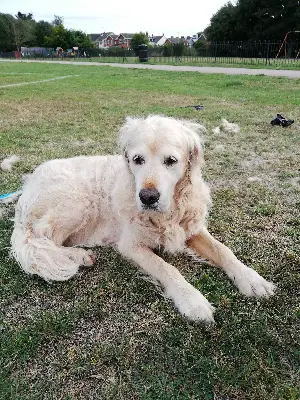
It’s fairly normal that when dogs lose some hair it is because they are scratching an itch.
But when they keep losing excessive amounts of hair without any signs of itch, you might be questioning what might be the cause.
Before we dive further into the topic, it should be remembered that shedding for dogs is completely normal.
There are also dog breeds that shed more than others because they have long or thick hair.
This is why when we talk about “hair loss” in this article, we will be referring to excessive hair loss that leads to visible thinning or bald spots.
By reading this article, you will learn:
- Why do dogs lose hair without itching or scratching?
- How are these causes diagnosed?
- Could a vitamin deficiency be the cause?
- Why else do dogs lose their hair?
- What are the most common areas on a dog for hair loss?
- Which dog breeds are more prone to hair loss?
- The best treatment for dog hair loss
- Can you use over the counter medications to treat dog hair loss?
- Effective home remedies for dog hair loss
Why do dogs lose hair without itching or scratching?
Hair loss in dogs (and humans) is commonly referred to as alopecia, and it can be caused by a variety of things.
Causes of alopecia with no itching in dogs include:
- Hypothyroidism
Hypothyroidism is the inflammation and shrinking of the thyroid gland.
This disease often induces hair loss in dogs and it’s not accompanied by itching or inflammation of the skin.
A unique trait of hair loss in dogs caused by hypothyroidism is the bald spots are symmetrical on each side of the body.
Other symptoms you can look for to see if your dog has hypothyroidism are weight gain, thickening of the skin in the armpits, and they get cold easily.
- Hereditary hair loss
While most dog hair loss is accompanied by itchiness, alopecia with no itch is often hereditary. Color dilution alopecia (CDA) is a genetic condition in dogs that causes hair thinning and hair loss in patches.
The hair loss usually doesn’t itch but itching can also occur if there’s a secondary skin infection. Other symptoms of hereditary hair loss are dull coat, graying hair, and melanoma formation.
- Pressure sores
When your dog keeps pressing or weighing onto the same spot, this may lead to hair loss.
This typically happens to dogs who are old and/or sick and immobile, with the most common pressure sore spots being on a dog’s elbows, hips, or sides.
You can by moving them so they don’t always lean on the same spot.
Constant pressure from a collar can also induce hair loss.
Make sure to remove your dog’s collar once in a while and don’t put them back on if their hair is thinning on the collar area.
- Skin cancer
Dogs with skin cancer often lose hair in the area of the tumor lump, and this hair loss doesn’t itch. Another symptom to look for is the presence of lumps, which might be ulcerated.
- Post-clipping alopecia
For some dogs with dense double coats, clipping their hair may cause it to grow back thin and patchy. This might cause it to look like they have bald patches, but their coat should grow back with time. If it doesn’t, you can contact the vet and ask for treatments.
How are these causes diagnosed?
If you bring your dog to the vet for hair loss, there are a few steps that the vet will take to diagnose them.
- Examine the pattern of hair loss
By seeing the pattern, a veterinarian should get a rough idea of what’s causing the problem. Losing hair in patches is often caused by ringworm or bacterial infection, while symmetrical hair loss is an indication of thyroid disorder or adrenal gland disorder.
- Blood testing
A sample of your dog’s blood will be taken and tested to see if they have certain immune system conditions, diabetes, or thyroid disorders.
- Biopsy
A biopsy is done to rule out skin tumors or cancer.
- Skin smears and scraping
This will basically show whether there are any bacteria, yeast, or parasites on the skin. A luminescence test might also be carried out to check for the presence of ringworms.
- Allergy testing
Finally, the vet will check if your dog has any allergies.
Could a vitamin deficiency be the cause?
As you probably already know, diet has a lot to do with everything. From physical to mental problems, in humans and dogs alike, what you eat will affect your health.
Some of the integral vitamins for dog hair health are:
- Omega-3 fatty acids. They help moisturize your dog’s skin and hair.
- Vitamin E. To prevent dry skin.
- Vitamin A. It supports the growth of hair cells and promotes sebum production.
- Biotin. For hair strengthening and also the production of fatty acids.
Deficiency in these vitamins might help induce your dog to lose hair. This doesn’t mean you should pile three servings of these vitamins in your dog’s next meal. Remember, too much of them can also cause trouble.
Instead, study the nutrients of your dog’s usual meal and see what they’re lacking. You can then add the lacking vitamins through foods or supplements. Some vitamins can also be added topically such as vitamin E.
Why else do dogs lose their hair?
As we’ve established, dogs often lose hair when they have an itch. Below are some of the most common reasons for hair loss in dogs.
- Allergies
The number one reason for hair loss in dogs accompanied by itching is allergies. This allergy can be to a variety of things, from certain foods, fleas, and pollen, to simple seasonal allergies.
- Parasites or Infections
Another common reason for hair loss and itching is parasites. If your dog is infested by parasites or infected by pests like ringworms, this usually leads to scratching and chewing on their skin. All this skin tugging will in turn lead to hair loss.
- Cushing’s Disease
Hyperadrenocorticism, most commonly referred to as Cushing’s disease, is a condition of overly high cortisol levels. Excessive amounts of cortisol can lead to changes in the skin structure, causing hair loss and other skin problems such as redness.
What are the most common areas on a dog for hair loss?
- Around the eyes and mouth
- On the head,
- neck,
- and body.
If the hair loss is genetic, the most commonly affected areas are on the ears, chest, lower neck, and belly.
Which dog breeds are more prone to hair loss?
Dog breeds that are more susceptible to alopecia are:
- Dobermans
- Chihuahuas
- Dachshunds
- Bernese mountain dogs
- Chow Chows
- Great Danes
- Poodles
- Yorkshire terriers
The best treatment for dog hair loss
Because the cause of dog hair loss greatly varies, the treatment will also differ depending on what’s causing the problem.
- For dog hair loss induced by bacterial infections
When it comes to infections, the first thing you have to do is of course manage the infection. Use antibiotics to treat the infection, this can be either oral or topical.
- For dog hair loss induced by fungal infections
Similarly, if the problem is a fungal infection, buy oral or topical antifungals.
- For dog hair loss induced by allergies
Allergy-related hair loss can be treated with several methods. Immunosuppressive or anti-cytokine drugs can be used to manage environmental allergy (atopy). Immunotherapy can also be used for allergy desensitization. If the allergy is food-related, the dog might have to practice a hypoallergenic diet recommended by the vet.
- For dog hair loss induced by thyroid diseases
Hair loss that’s caused by a thyroid disease needs a more complex treatment. The disease is usually treated with hormone therapy and thyroid medications.
- For dog hair loss induced by skin cancer
Lastly, if your dog is losing hair due to skin cancer or tumor, the tumor has to be lifted through surgery to stop hair loss in the affected area.
The bottomline is when it comes to hair loss, what you need to treat is the cause of the hair loss itself. There’s no medication that will target the hair loss itself without treating the cause. Unfortunately, if the hair loss is hereditary, there’s no treatment for it.
Can you use over the counter medications to treat dog hair loss?
Yes, there are OTC medications for hair loss in dogs. Make sure to read the labels carefully and ask the vet to make sure you’re choosing the medication best suited for your dog’s condition.
For hair loss caused by allergies, you can buy antihistamines like Benadryl or Claritin. Antibiotic ointments like Neosporin or antifungal sprays can be bought over the counter.
Effective home remedies for dog hair loss
- Use moisturizing shampoo
The first step in managing your dog’s hair loss is in their most basic hair care: their shampoo. One of the factors that promote hair loss in dogs is dry skin and hair. Switch to a dog shampoo that is extra moisturizing–or better yet, specially formulated for hair loss.
- Brush your dog’s hair
Still keeping it very simple, the next thing you should do is brush your dog’s hair regularly. This will help spread out their natural skin oil to their skin and fur, keeping them naturally moisturized.
- Use diluted apple cider vinegar
Apple cider vinegar or ACV is known to carry plenty of benefits for health and beauty. For skin and hair, it helps balance pH. It’s also very simple to use, just dilute organic ACV with water to make a 1:1 blend and put it into a spray bottle. Spray the solution onto your dog’s coat every day. Never apply undiluted ACV on their skin because it’s too harsh.
Other home concoctions often used to treat hair loss are lemon juice, olive oil, aloe vera, and flaxseed oil.






